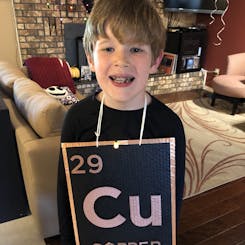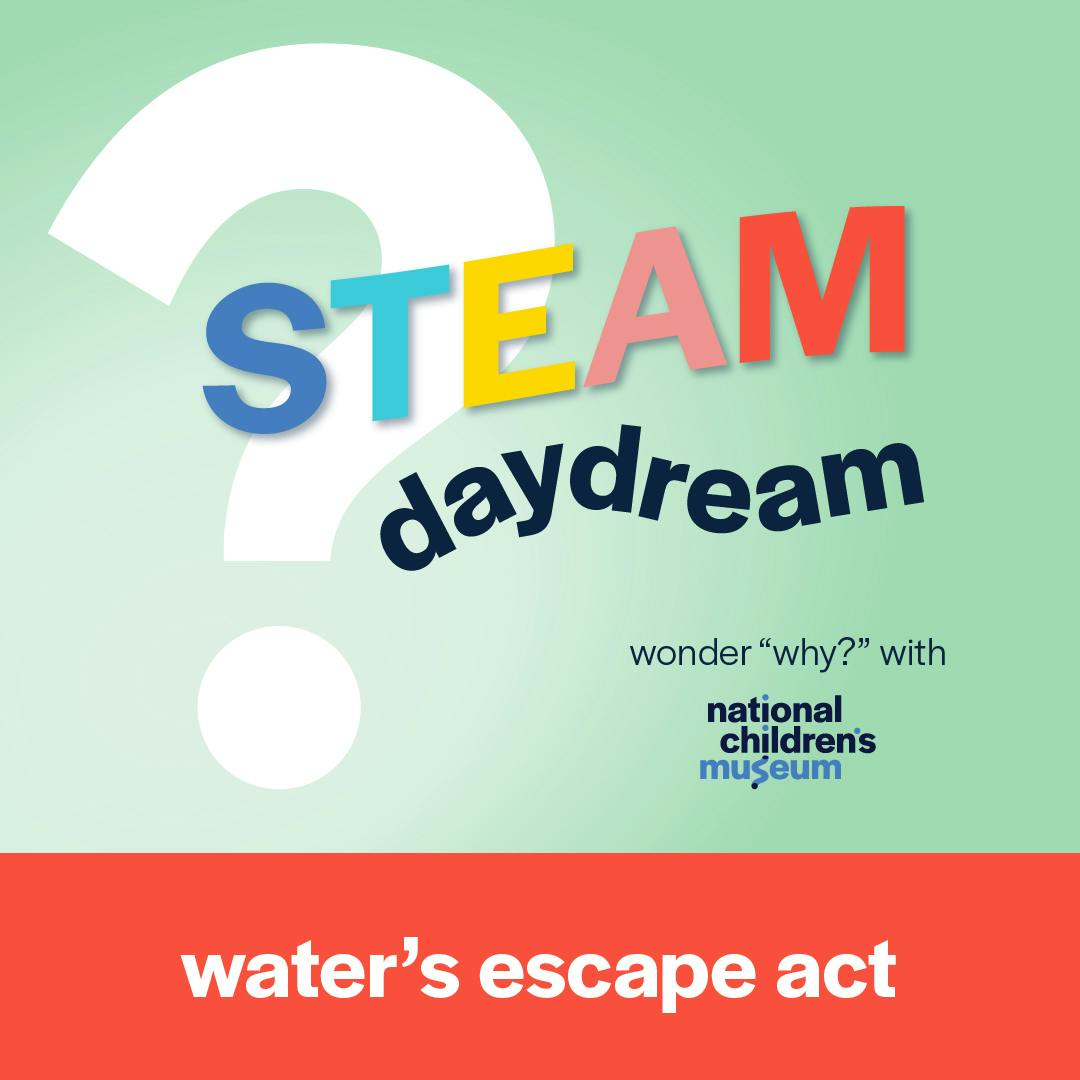water’s escape act
8-year-old Kid Investigator Charles recalls the Taco Tuesday where he first noticed something strange… As he began to sweat (too much hot sauce), so too did his glass. He meets Aubrey and Andre in the STEAM Daydream studio to recreate the situation—minus the tacos. Will they be able to solve the mystery of where the water on the outside of the glass is coming from?
 meet our kid investigator Charles. S. (he/him) from Springfield, Virginia 8-years-old favorite school subject: science and PE |
 meet our expert Tom Di Liberto (he/him) Climate Scientist at the National Oceanic and Atmospheric Administration fun fact: "A lot of people who study our atmosphere can point back to an individual storm that sparked their interest. For me, it was the Blizzard of 1996 where I got to play in over two feet of snow!" |
- matter: anything in the world that takes up space, including the things we see (like a chair) and the things we can't see (like the air)
- states of matter: the different forms that materials in the world can exist in, including solid solids, liquids, and gases
- solids: matter that has a set size and shape, like a shoe or a tennis ball
- liquids: matter that has a set size but take the shape of the container that it's in, like water in a pool
- gases, or gaseous state: matter that does not have a set size or shape, like air
- water vapor: water in its gaseous state
- condensation: the process by which water in its gaseous form turns into liquid water
- 2-PS1-1 Matter and Its Interactions: Plan and conduct an investigation to describe and classify different kinds of materials by their observable properties.
- 2-ESS2-3 Earth's Systems: Obtain information to identify where water is found on Earth and that it can be solid or liquid.
- 5-PS1-2 Matter and Its Interactions: Measure and graph quantities to provide evidence that regardless of the type of change that occurs when heating, cooling, or mixing substances, the total weight of matter is conserved.
- 5-ESS2-2 Earth's Systems: Describe and graph the amounts and percentages of water and fresh water in various reservoirs to provide evidence about the distribution of water on Earth.
AUBREY: [panting, out of breath] A.J., wait up! Andre and I just finished research for today’s show! Right, Andre?... Andre?
ANDRE: Coming! I was just finishing organizing all of the souvenirs from our trip. Fresh spring water from Colorado, a horse shoe from Oklahoma, this cactus—OUCH!—from Arizona…
A.J.:
AUBREY: Our 50-state research road trip, silly! When we were on the phone last week, you said we would be solving a mystery… A mystery about changing states! So, Andre and I organized a cross-country trek!
ANDRE: That’s right! We changed states 50 times, so we’re really prepared for today.
A.J.: Oh no… When I said today’s mystery was going to be about changing states, I didn’t mean traveling between the 50 states in America. What I meant was transforming from one state to another.
ANDRE: Oh, oh! We did that too! When we were in Oregon, we meditated right before we crossed into Idaho. I was totally transformed.
AUBREY: Oh, yeah! Totally transformed.
A.J.: That’s not quite what I meant either.. Today’s show is actually about changing from one state of matter to another. You know, like, when water transforms from its gaseous state to its liquid state?
ANDRE: Hmmmm…
AUBREY: Uh-huh…
A.J.: Ok, why don’t you both come upstairs to the studio with me. Our Kid Investigator will be able to clear some things up for you.
[THEME MUSIC]
A.J.: You’re listening to Season 2 of STEAM Daydream with National Children’s Museum, where we solve the world’s many STEAM mysteries, one episode at a time: we’ll observe, we’ll ask questions, we’ll investigate, we’ll research, and then we’ll connect the dots! I’m A.J., and—
[BARK/MEOW]
A.J.: Newton! Not now, I’m in the middle of recording. Sorry, everyone, that’s my cat, Newton. And yes, I did teach him to bark…unfortunately…
[BARK/MEOW]
A.J.: As I was saying, here to help solve today’s mystery is Charles, our 8-year old Kid Investigator from Springfield, Virginia! Take it away, Charles!
CHARLES: Thanks, A.J.!
ANDRE: Hey, I think there was a little miscommunication. What exactly are we investigating?
CHARLES: Andre, let me take you back to last week, when this mystery began for me.
[MUSIC]
CHARLES: It was Tuesday—my favorite day of the week.
AUBREY: Why is Tuesday your favorite day of the week?
CHARLES: Because every Tuesday we have tacos…for Taco Tuesday!
[MUSIC]
ANDRE: I love Taco Tuesday! Are you a hard shell or soft shell kind of taco eater? Personally, soft shells—
AUBREY: Andre! Today’s mystery is not which taco shell is superior! I’m listening, Charles…
CHARLES: So I sat down at the table for dinner and started building my taco as usual. The tortilla, then the meat and pickles and of course anchovies, topped with some mild salsa—or what I thought was mild salsa… Until I took my first bite and my mouth was on fire. I ran to the fridge and poured myself a glass of water with extra ice and took a few sips to cool off. By the time I had finished eating, I observed something very strange.
ANDRE: What was it?!
AUBREY: Yeah, what happened?!
CHARLES: Here, let me show you. I have a clear drinking glass here. I’m going to fill it up with ice and water. Now, watch!
AUBREY: What are we looking for exactly?
CHARLES: Just wait. You’ll see.
ANDRE: Can I blink yet?
CHARLES: Yes, Andre, you can blink.
AUBREY: I don’t see anything.
CHARLES: Try touching the glass. Do you notice anything?
AUBREY: Well, it’s cold, and… it’s…wet!? Why is it wet on the outside of the glass?
ANDRE: The outside? The water is on the inside, silly.
AUBREY: But the glass is wet! Feel it! And there’s a tiny puddle underneath it.
ANDRE: What on Planet Mars…
CHARLES: This is exactly what happened with my glass of water on Tuesday! As I finished my taco, I realized my water glass was soaking wet.
AUBREY: Well, it must just be this glass. Do you have any more glasses?
CHARLES: Sure, here’s one for you and one for you.
ANDRE: Can I have ice water, too? But hold the ice.
CHARLES: So just water? Sure, here’s some room temperature water for you.
ANDRE: Thank you.
CHARLES: And some for you, Aubrey…
AUBREY: Wait! Can I actually have hot chocolate instead, please?
CHARLES: But Aubrey, it’s 90 degrees outside!
AUBREY: It’s never too hot for hot chocolate!
CHARLES: But I don’t have any hot chocolate.
AUBREY: Oh, that’s ok. I brought my own!
CHARLES: Anyway, let’s let these glasses sit for a few minutes to see if the same thing happens.
CHARLES: Aubrey! Stop!
AUBREY: Fine, I promise I won’t drink our science experiment.
CHARLES: Ok, it’s been a few minutes. Let’s take a look at the two new glasses. Notice anything weird?
[MUSIC]
ANDRE: Ah, ok this one with the hot chocolate is still pretty hot. The one in the middle with just the water isn’t hot, and it isn’t cold, it just feels normal.…and this one with the ice water is definitely still wet! There’s got to be a teeny tiny hole or crack somewhere.
AUBREY: Of course! Let’s wipe it off to see if it leaks again. Hm, nothing.
ANDRE: If the water on the outside of the glass isn’t leaking from the inside the glass, I wonder where it’s coming from…
AUBREY: Yeah, and why isn’t the water clinging to the outside of the other two glasses?
CHARLES: See, that’s the mystery. Now, let’s start with what we know.
AUBREY: We know that inside the glass is water.
CHARLES: Andre, can you tell us what water is?
ANDRE: Psht, of course! Water is… Water is… Water? Is this a trick question?
AUBREY: I have an idea! Let’s phone our friends at National Children’s Museum to see if they know anything about water. Caitlin is there, let me just give her a call.
CAITLIN: Hello?
AUBREY: Hey, Caitlin! It’s Aubrey!
CAITLIN: Oh, hey, Aubrey. What can I do for you?
AUBREY: Well, I’m with Andre and our friend Charles who’s helping us solve today’s STEAM mystery. We were wondering if you could survey the crowd at the Museum to see if they know anything about water. It seems to be escaping us…and the glass it’s in, come to think of it.
CAITLIN: Sure, let me ask around!
[MUSIC]
CHILD 1: My name is Ella. I’m 10 years old, and I live in Falls Church, Virginia. Water is a liquid that people drink. I drink it when I’m thirsty and also like with my meals.
CHILD 2: Hi, my name is Annabelle and I am 9 years old and I’m from [inaudible]. Water is something you can like drink and it’s like in the ocean.
CHILD 3: Water is a liquid that we drink and we swim in and we take showers with.
CHILD 4: Water takes like nothing really, but I like it.
CHILD 5: My name’s Jet. It tastes like ice to me. I like to drink it out of my water bottle
CHILD 6: I’m Caleb, and I’m 9-years-old, and I am from Florida. Water just tastes like a plain liquid. Water is actually like the only liquid that actually keeps you hydrated if you didn’t know.
CHILD 7: Water tastes like nothing, but I like my water cold.
CHILD 8: Like for other foods, I can say that tastes like water, but I don’t know what to say water tastes like.
CHILD 9: It doesn’t really taste like anything.
AUBREY: Thanks, Caitlin, and a special thank you to the Dreamers at National Children’s Museum for those interesting water facts. Very helpful.
ANDRE: Speaking of helpful, while you were on the phone with Caitlin I found an entry for water in my handy dandy pocket encyclopedia. Look!
AUBREY: It says here, “Water is made up of molecules, which are made up of units called atoms. Water can be found in three physical states: liquid, solid, or gas.”
ANDRE: Did you understand any of that?
CHARLES: I bet our friend Tom Di Liberto might be able to explain it.
TOM: Hi, I'm Tom Di Liberto. I'm a climate scientist at the National Oceanic and Atmospheric Administration, or NOAA. I study everything you see outside. I study our atmosphere and our ocean. I try to figure out what sort of weather and climate is going to be like next week, next month, or next year. We interact with the states of matter every single day. The states of matter are liquid, solid, and gas; and water could be in all three of those. When it's liquid water, it's like water in a glass or when you jump into a pool. Solid water is ice or snow. If it's cold outside and you go skiing or a snowball or snowman. While gas, if you're outside right now, there's water in the air all around you. You just can't see it. It's very, very tiny levels. So an example of water in its gas state is when you're boiling a pot of water on the stove to make pasta, you can see it's starting to bubble. You start to see the steam rising from it. What you're actually seeing is water moving from its liquid state into its gas state. Water changes states by either giving it more energy or taking away energy from it. So an easy way of figuring out how much energy is kind of related to the temperature or something. When you're really cold, you don't really want to move a lot. You're kind of stationary. Water molecules are kind of the same way. They don't want to move a lot when they're in their solid state. Where you increase the temperature a little bit, now it's in its liquid phase, you're moving around a little bit. Let's say you're walking down the street, but then when you put even more energy in, you make the temperature even hotter. Those water molecules now in the gas state are like you running around in a field really, really fast and they're running everywhere. You can see when water is solid, you can see when water is liquid, but you can't really see when water is in its gas phase because those gas molecules are running around everywhere in the atmosphere.
AUBREY: Okay, I get it now. Water is made up of tiny individual water molecules. The molecules are always in motion. The warmer they are, the faster they move. And the colder they are, the slower they move.
CHARLES: Exactly. And when the molecules move slowly, they gather close to each other. When they're moving fast, they're spread really far apart.
ANDRE: Makes sense. But what does that have to do with our mystery?
AUBREY: I have a feeling Tom might know. Tom?
TOM: So condensation is when water goes from its gas state into its liquid state. There is water in all of the air around us, even if we can't see it. But when you cool the air around us, which means we also cool those air molecules, we actually can change water from its gas state into its liquid state, and we can often see that as condensation. So have you ever walked outside on a spring day? And it's kind of cool outside still, but you look out and there's no clouds in the sky, but somehow the grass and all the plants are wet? That's condensation. Have you ever seen a cloud form? If you can see the cloud in the sky, what you're looking at is actually itty bitty, tiny, liquid water droplets that have condensed in our atmosphere. Or better yet, you've walked through one of those before, too. If you've ever walked through fog. You woke up one morning and you see this kind of cloudy atmosphere right down by the ground? That's tiny little liquid water droplets that have condensed out of water from it gas state.
CHARLES: That explains it! Aubrey and Andre, ready to solve this mystery?
AUBREY: Wait! Ok, now I’m ready.
CHARLES: Aubrey, is that hat really necessary?
AUBREY: This isn’t just a hat—this is my thinking cap! I couldn’t possibly solve a mystery without my thinking cap on.
CHARLES: Whatever you say… You ready, Andre?
ANDRE: Oh, yeah!
CHARLES: Great, let’s connect the dots!
[MUSIC]
ANDRE: So the water in this glass—the one that’s wet and surrounded by a puddle—is the coolest.
AUBREY: Yes, the most awesome water I’ve ever met!
ANDRE: Not like that Aubrey, I mean cool as in the temperature!
AUBREY: Ohhh, gotcha, I’m with you now! Yes, very cold. Brrrr.
ANDRE: It’s pretty cold because it has ice cubes in it, which are water molecules that are so cold and are moving so slowly that they gather together to form a solid chunk of water.
AUBREY: That’s right! Meanwhile, the temperature of the air in the studio is much warmer than the temperature of the ice cold water. Newton likes it to be nice ‘n toasty in here. Isn’t that right, Newton?
[BARK/MEOW]
AUBREY: The air in this room, like any room, contains water molecules, too. We just can’t see them because they are in a gaseous state of water vapor. They’re moving so fast and spreading far enough apart that we can’t see them.
ANDRE: Until they collide with the surface of the cold glass!
AUBREY: Exactly! When the warm air of the room, which contains the invisible water vapor, bumps into the cold glass, the water vapor molecules start to get colder too. As they cool down, the molecules start to move slower and slower. Eventually, the water molecules get so cold and move so slow that they transform into liquid water. This transformation from a gas to a liquid is called condensation.
CHARLES: Which means the water on the outside of the glass is actually coming from the air inside this room!
[MUSIC]
ANDRE: And the reason the glasses with the room temperature water and the hot chocolate don’t have condensation on the outside of them. It’s because the glasses surface isn't cold enough to slow down the water vapors’ molecules.
AUBREY: Bingo!
CHARLES: We did it! We solved the mystery!
A.J.: Way to go, team! Our very first STEAM mystery solved! Want to investigate the three states of water further? Come visit us at National Children’s Museum to check out our Weather Worlds green screen experience, where you can use superpowers to affect the weather. As you change the weather, notice how many different states of water there are. Which part of the experience involves condensation? Think you know? Email [email protected] with the correct answer! You can also check out the Museum’s Head in the Clouds virtual field trip video to discover different types of clouds that all have one thing in common—they’re products of condensation! That’s all for today’s episode, Dreamers! Join us next time to get to the bottom of a truly shocking STEAM mystery. In the meantime, if you enjoyed today’s show, please leave a review to help other curious kids discover our podcast, and be sure to subscribe wherever you’re listening so you don’t miss our next adventure. You can find more STEAM programs and resources on our website at www.nationalchildrensmuseum.org. Season 2 of STEAM Daydream with National Children’s Museum is generously sponsored by GEICO. It iss narrated by me, A.J. Calbert, produced by Paige Childs, with sound design and engineering by Maddie Zampanti of Conceptual Podcasting.

